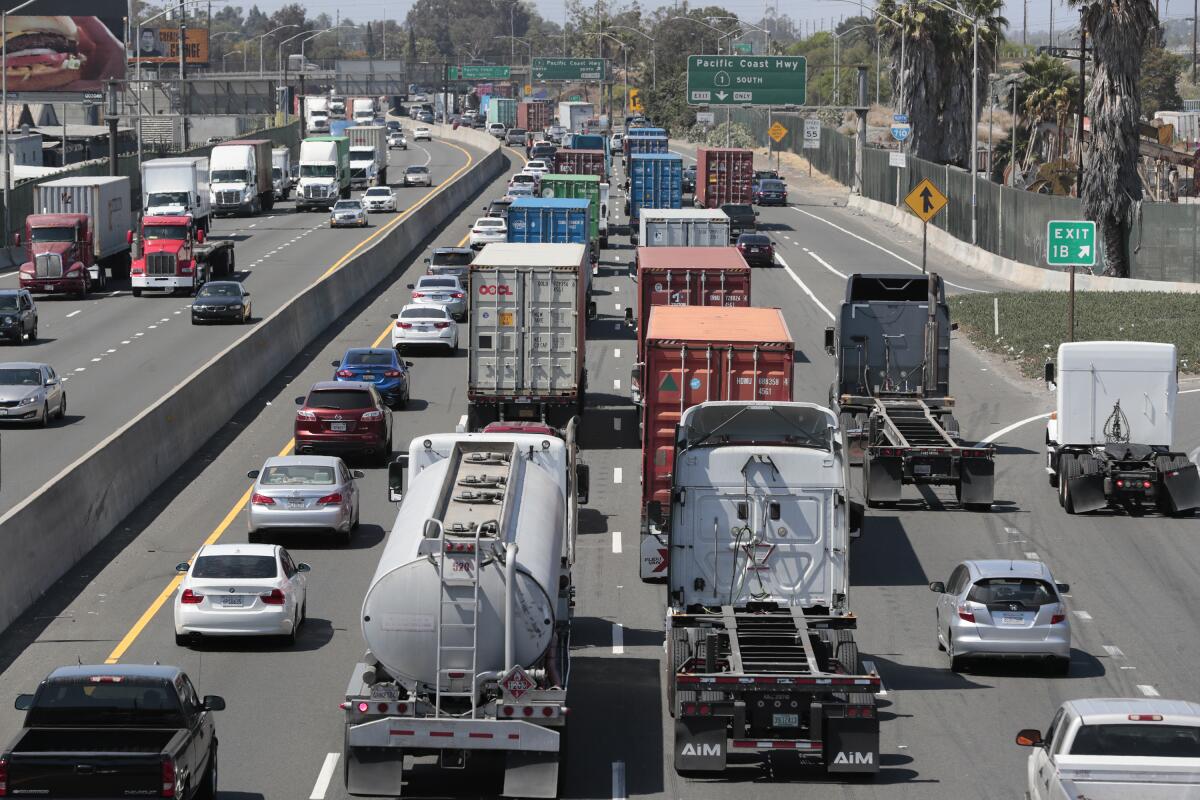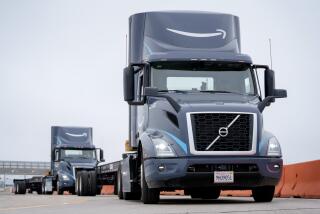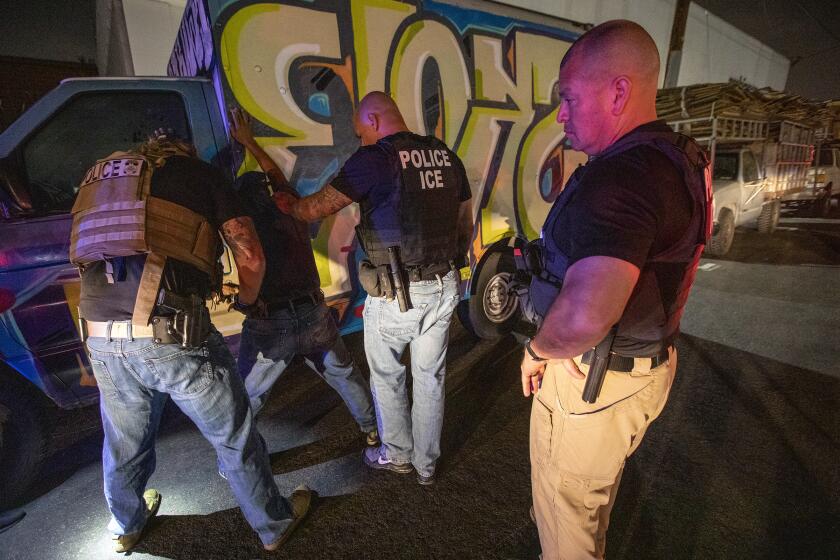Biden’s EPA proposes new rule to reduce smog from trucks and other heavy vehicles

- Share via
The Biden administration is proposing new emission standards that would reduce smog-forming pollutants from tractor-trailer trucks, buses and other heavy-duty vehicles as part of a multiyear plan to improve air quality across the nation.
The draft rule proposed by the Environmental Protection Agency, which would take effect in model year 2027, would reduce emissions of g nitrogen oxides from gasoline and diesel engines by as much as 60% in 2045, the agency said. It would also set updated greenhouse gas standards for certain commercial vehicle categories, including school buses, transit buses, commercial delivery trucks and short-haul tractors — subsectors in which electrification is advancing more rapidly, the EPA said.
The proposed rule change was modeled after smog-curbing regulations already adopted by the state of California, although the federal requirements would be less stringent. Many air quality advocates said the rule doesn’t go far enough.
“We’re disappointed that it doesn’t do more, especially when it comes to requiring electrification of these heavy-duty trucks,” said Paul Cort, senior attorney with San Francisco-based environmental law nonprofit Earthjustice.
EPA Administrator Michael S. Regan said more than 70 million people live near truck freight routes in the U.S., populations who are “more likely to be people of color and those with lower income.”
“Those overburdened communities are directly exposed to pollution that leads to respiratory and cardiovascular problems,” Regan said Monday at a White House event unveiling the rule and other measures being taken by the Biden administration to reduce transportation-related pollution and greenhouse gases.
Vice President Kamala Harris hailed the proposed rule and other administration actions as being necessary to reduce dangers posed to lower-income communities by truck pollution.
As California’s attorney general, she said, she visited Mira Loma, a town in Riverside County “that had some of the worst air pollution in the state” due to the 15,000 large trucks that crisscross its roads each day. Their “soot and exhaust,” Harris said, has “turned the air toxic.”
“The first time I went to Mira Loma, you could taste the metal in the air,” she said, adding that studies showed children in the town suffered from the poorest lung development in the state.
“There are many Mira Lomas in our country,” she said, “where pollution from heavy-duty trucks and buses have made the air poisonous to breathe.”
In Southern California, such communities can be found along the 710 Freeway corridor — which serves as a major artery for the movement of goods to and from the ports of Los Angeles and Long Beach — and in the Inland Empire — which serves as a logistics hub for online shopping warehouses.
Although heavy-duty diesel trucks make up just a tiny fraction of vehicles on the road, they produce more than half the on-road pollution in California, said Will Barrett, national senior director for clean air advocacy for the American Lung Assn.
“Nitrogen oxide is a main ingredient in ozone or smog, and we know that Southern California has the smoggiest air in the United States,” he said. “This rule is really getting to the heart of reducing smog emissions that contribute to both local and regional air pollution burdens.”
The proposal outlines two options. The more stringent one would limit emissions to 0.035 gram of nitrogen oxide pollution per brake-horsepower hour, a standard unit for measuring engine output, by 2027, and then to 0.02 gram by 2031, Cort said. The other would set a limit of 0.05 gram of nitrogen oxide pollution per brake-horsepower hour in 2027 and leave it at that level, he said.
California in 2020 passed a rule limiting truck emissions to no more than 0.05 gram of nitrogen oxide pollution per brake-horsepower hour by 2024 and to 0.02 gram by 2027. That means that only the more ambitious rule proposed by the EPA would catch up to that set by the state, and it would do so four years later.
“There’s so much happening on the West Coast that they’re just not tracking back in D.C.,” Cort said. “And so I think it’s almost like they just haven’t kept up with what’s going on with the technology.”
The 2020 ruling by the California Air Resources Board introduced a tiered approach to lowering nitrogen oxide levels with benchmarks set through 2031, at which point the state’s engine standards would be among the most stringent in the country, said Matt Schrap of the Harbor Trucking Assn.
The board expects to reduce nitrous oxide emissions in the state by more than 23 tons per day, which is the equivalent of taking 16 million cars off the road.
At the time, the Truck and Engine Manufacturing Assn. called the new regulations “not technologically feasible or cost-effective.” The industry was already trying to address regulations requiring manufacturers to increase the number of zero-emission vehicles sold in the state.
Then truck and engine makers expressed interest in a national rule rather than a state one. Schrap suspects that, of the two options, federal regulators will choose the one closer to California’s.
“California has been driving federal engine standards for years,” he said.
The American Lung Assn. plans to participate in the public comment portion of the EPA rule-making and is evaluating where the standards can be strengthened, Barrett said.
“We’d like to see the federal rule accelerate to get on track with where the California rule is,” he said.
Ed Avol, a professor of clinical preventive medicine at USC, said it’s encouraging to see the EPA move forward with the regulations because the health data clearly show the advantages of reducing exposure to pollutants.
“However, the timelines and expectations are for decades into the future, and the health disparities continue right now,” Avol wrote in an email.
“It is particularly discouraging to see the EPA tout that by 2045, emissions will be reduced 60%; that is over 20 years from now, and means that additional generations of children will continue having to grow up breathing unhealthy air.”
The rule also contains no requirement that a certain number of truck sales be zero-emission. This is in contrast to California, which in 2020 passed a rule requiring manufacturers to begin selling zero-emission models in 2024 and to make those vehicles an increasing share of their sales each year until 2045, when all trucks sold in the state must be clean.
Wayne Nastri, executive officer for the South Coast Air Quality Management District, said in a statement that the EPA’s proposal “has been a long time coming and is sorely overdue.”
“We urge U.S. EPA to move quickly on finalizing the most stringent version of this plan by the end of this year that is more in line with the stronger standards already set by California,” Nastri said. “One that will provide the most benefits by 2027, not 2031. We owe it to our communities.”
The EPA estimates that if the more ambitious option is chosen, the U.S. will by 2045 see thousands of fewer premature deaths, hospital admissions and cases of asthma onset in children, as well as millions of fewer cases of asthma and allergic rhinitis symptoms.
The action is being billed as the first step in a series of regulations the EPA will develop over the next three years to reduce pollution from trucks and buses.
Separately, the EPA plans to set new greenhouse gas emission standards for heavy-duty vehicles as soon as model year 2030, the agency said.
Just because the agency’s proposal falls short of what California has already done doesn’t mean the state won’t realize benefits, according to some experts.
“We know that approximately half of the truck traffic in California is interstate, so we know there is a significant additional benefit to be had by the federal government taking this action,” Barrett said.
It would also ensure the standards remain in place if there is a successful challenge to California’s authority to implement its own emission controls, said Julia Stein, project director for the Emmett Institute on Climate Change and the Environment at UCLA School of Law.
“This rule is largely drawing on work that’s been done in California and a rule that’s already been adopted in California,” she said. “So this is yet another example of California being out ahead on this regulation and the federal government moving to adopt effective regulations that California has already explored.”
More to Read
Sign up for Essential California
The most important California stories and recommendations in your inbox every morning.
You may occasionally receive promotional content from the Los Angeles Times.













